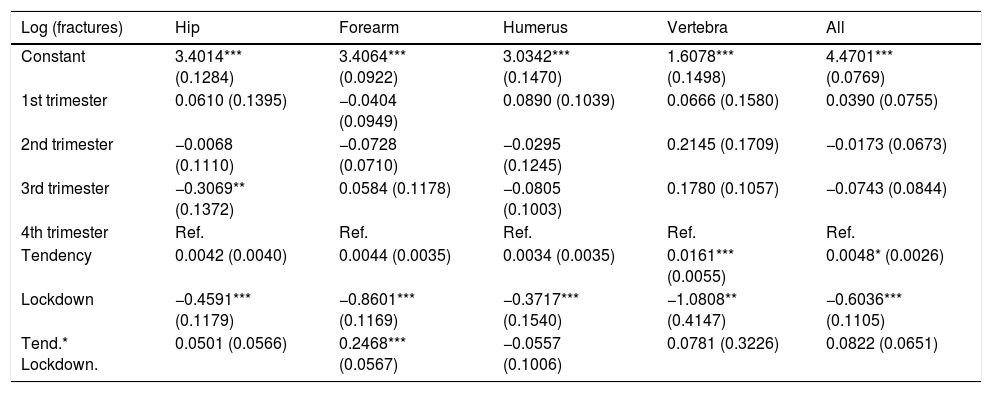On 15 March 2020, a period of strict lockdown entered into force for the Spanish population due to the COVID-19 pandemic. This lockdown lasted until 15 June, the date when the Canary Islands entered the stage known as the “new normal”. Prior to that, on 11 May in the island of Gran Canaria, the de-escalation began with entry into phase 1, and then entry into phase 2 took place on 25 May. During these phases permitted activities were limited.
We studied the side effects of COVID-19 in the general health of the elderly population. The objective was to analyse the effect on the incidence of «major» fractures (clinical vertebral, hip, humerus and forearm)1 in the lockdown period due to COVID-19 in the northern area of the Island of Gran Canaria.
The University Hospital of Gran Canaria is a tertiary hospital in the north of the island that provides health coverage to a population of 350,000 inhabitants >14 years of age. An observational study was carried out, reviewing the electronic records of the emergency service of our institution during the months of January 2017 to June 2020, both inclusive. The inclusion criterion was patients 50 years of age or older with a «major» fragility fracture. The ICD-10-ES classification was used,2 established as a protocol for the identification of patients in the context of the hospital’s Fracture Liaison Service.
The statistical analysis was based on the comparison of the incidence of fracture during the duration of lockdown (March, April and May) versus the same period in the years 2017–2019 (Newey-West and Cumby-Huizinga methods).
During the months of March, April and May 2020, 190 «major» fractures were registered (hip 72, forearm 56, humerus 48, vertebra 14). In the same period during 2019, 304 fractures were registered (hip 110, forearm 95, humerus 71, vertebra 28) (reduction of 37.5%).
The average number of fractures during the months of March, April and May from 2017 to 2019 was 107.3, 90.7 and 105.7, respectively, compared to 64, 54 and 72 fractures in 2020 (reduction of 40%, 40% and 32%, respectively). According to the fracture type, the reduction in fractures in the months of March, April and May 2020 compared to the average from 2017 to 2019 was 32.7% in hip fractures, 43.6% in forearm, 33.3% in humerus and 44.7% in vertebral fractures. In June 2020, the number of fractures was 97, 18.3% higher than in 2019 and 11.1% higher than the average from 2017 to 2019.
The analysis of interrupted series shows a statistically significant drop in the number of fractures from March 2020 onwards, for all types of fracture (Table 1). In the case of hip fractures, the estimated reduction is 36.8% (exp(−0.4591)−1). In the case of hip fractures, the model also shows a lower incidence in summer. The forearm fractures fell 57.7% in March, 45.8% in April and 30.7% in May. Humerus fractures were reduced by 31.0%, and vertebral fractures by 66.1%. The analysis of the total number of “major” fractures shows a 45.3% reduction in incidence compared to that which would be expected if there were no lockdown.
Analysis of interrupted series, January 2017 to May 2020. Coefficient (standard error).
| Log (fractures) | Hip | Forearm | Humerus | Vertebra | All |
|---|---|---|---|---|---|
| Constant | 3.4014*** (0.1284) | 3.4064*** (0.0922) | 3.0342*** (0.1470) | 1.6078*** (0.1498) | 4.4701*** (0.0769) |
| 1st trimester | 0.0610 (0.1395) | −0.0404 (0.0949) | 0.0890 (0.1039) | 0.0666 (0.1580) | 0.0390 (0.0755) |
| 2nd trimester | −0.0068 (0.1110) | −0.0728 (0.0710) | −0.0295 (0.1245) | 0.2145 (0.1709) | −0.0173 (0.0673) |
| 3rd trimester | −0.3069** (0.1372) | 0.0584 (0.1178) | −0.0805 (0.1003) | 0.1780 (0.1057) | −0.0743 (0.0844) |
| 4th trimester | Ref. | Ref. | Ref. | Ref. | Ref. |
| Tendency | 0.0042 (0.0040) | 0.0044 (0.0035) | 0.0034 (0.0035) | 0.0161*** (0.0055) | 0.0048* (0.0026) |
| Lockdown | −0.4591*** (0.1179) | −0.8601*** (0.1169) | −0.3717*** (0.1540) | −1.0808** (0.4147) | −0.6036*** (0.1105) |
| Tend.* Lockdown. | 0.0501 (0.0566) | 0.2468*** (0.0567) | −0.0557 (0.1006) | 0.0781 (0.3226) | 0.0822 (0.0651) |
In a Spanish study, a reduction in visits to the emergency department for fracture trauma was observed during lockdown. However, statistically significant differences in the reduction of the absolute number of hospital admissions for hip fracture were not found.3 An Iranian study has also reported a significant reduction in the total number of fractures in the months of March and April 2020.4
In one study, it was observed that vertebral fracture occurs mainly within the home, and that hip fracture occurs with equal frequency whether indoors or outside.5
In conclusion, we found a 45% reduction in fractures, an overall reduction in all fragility fractures during lockdown.
FundingThe authors declare that they have not received funding to carry out this work.
Please cite this article as: Naranjo A, Ojeda S, Negrín MÁ. Impacto del confinamiento durante la pandemia por SARS-CoV-2 en la incidencia de fractura por fragilidad. Med Clin (Barc). 2021;156:464–465.







